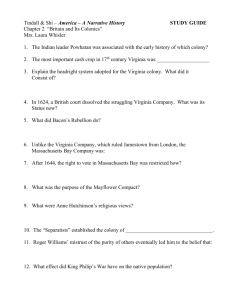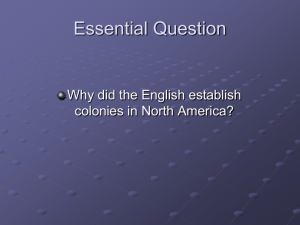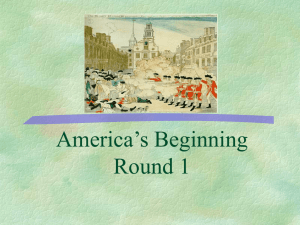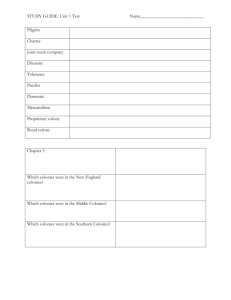AP US History Chapter 2 Study Guide – New World Experiments
advertisement
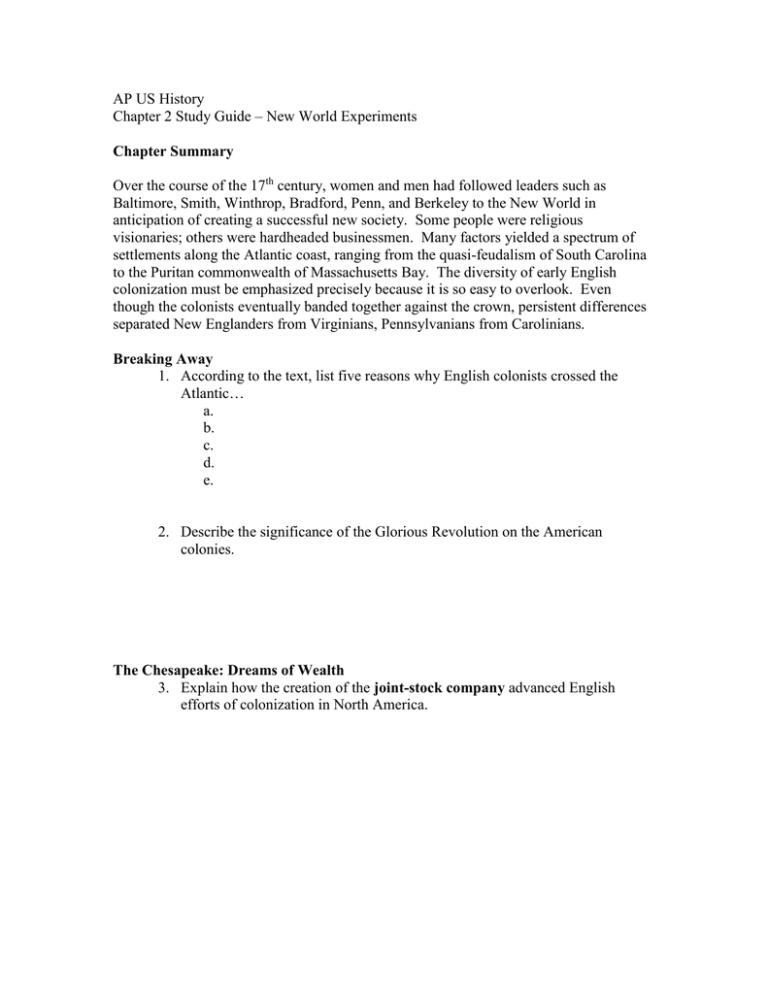
AP US History Chapter 2 Study Guide – New World Experiments Chapter Summary Over the course of the 17th century, women and men had followed leaders such as Baltimore, Smith, Winthrop, Bradford, Penn, and Berkeley to the New World in anticipation of creating a successful new society. Some people were religious visionaries; others were hardheaded businessmen. Many factors yielded a spectrum of settlements along the Atlantic coast, ranging from the quasi-feudalism of South Carolina to the Puritan commonwealth of Massachusetts Bay. The diversity of early English colonization must be emphasized precisely because it is so easy to overlook. Even though the colonists eventually banded together against the crown, persistent differences separated New Englanders from Virginians, Pennsylvanians from Carolinians. Breaking Away 1. According to the text, list five reasons why English colonists crossed the Atlantic… a. b. c. d. e. 2. Describe the significance of the Glorious Revolution on the American colonies. The Chesapeake: Dreams of Wealth 3. Explain how the creation of the joint-stock company advanced English efforts of colonization in North America. 4. Describe the settlement of Jamestown in social, geographic, and economic categories. Social Geographic Economic 5. Identify the role and significance of Captain John Smith. 6. Explain the perils facing the inhabitants of Jamestown from 1609-1610. 7. Explain the significance of tobacco on the Virginia colony. 8. Describe two efforts of Sir Edwin Sandys and their effect on life in Virginia. a. House of Burgesses b. Headright System 9. Elaborate on the lifestyle of indentured servants. 10. Explain the significance of Lord Baltimore. a. Why was his “Act Concerning Religion” significant? Reforming England in America 11. Describe the Mayflower Compact. 12. How is it that Puritans are “more like today’s radical political reformers”? 13. Identify the major difference between the charter of the Massachusetts Bay Colony and that of others created before it. 14. Compare/Contrast the individuals of Massachusetts (Puritans) and those of Virginia. 15. Explain the significance of John Winthrop’s “City on a Hill”. 16. Briefly elaborate on the significance of the church in Massachusetts Bay Colony. a. The town? 17. Describe the beliefs of Roger Williams. Why would these beliefs trouble Puritan leaders? a. Anne Hutchinson? 18. Describe the circumstances behind the creation of the following colonies. New Hampshire Connecticut Rhode Island Diversity in the Middle Colonies 19. Identify the purpose of Dutch settlement of New Netherland. 20. Describe the inhabitants of New Jersey. Quakers in America 21. Describe the religious beliefs of Quakers. a. How did they practice humility? 22. Who was William Penn and what was his “Holy Experiment”? Planting the Carolinas 23. What effect did Enlightenment thinkers have on Carolinian government? The Founding of Georgia 24. What political and social situations prompted England and James Oglethorpe to found the colony of Georgia? a. Political b. Social 25. Summarize the selected colonies using the provided categories. Virginia Massachusetts Pennsylvania Original Purpose Hardships Government Key Leaders Economy New York APUSH Chapter 3 Study Guide Chapter Summary Each colony developed a different social order depending on the local labor supply, the abundance of land, the demographic pattern, and whether there were strong commercial ties to their mother country, England. The differences between the colonies and its inhabitants also bring about tension. Whether religious or political, these problems bring some of the first signs of discontent in the colonies. Sources of Stability: New England Colonies of the Seventeenth Century 1. Explain how the family essential to the maintenance of social order. How does this reflect the type of people who came to New England? 2. Describe the family-based education system established by New Englanders. 3. Identify America’s first institution of higher learning. What did most of its early graduates become? 4. In what ways were women working “alongside” their husbands in Puritan New England? a. In what ways were there inequalities? 5. Who were the yeomen? The Challenge of the Chesapeake Environment 6. Classify the individuals that came to inhabit the Chesapeake area. 7. Identify the cause of a higher mortality rate among colonists in this region. Predict what may have caused this trend. 8. Evaluate how tobacco generated inequality in the Chesapeake region. 9. Identify the significance in the “emergence of a creole majority” in Virginia and Maryland. 10. How did the decrease in opportunity for social mobility in the Cheskapeake influence further colonization in the colonies? Race and Freedom in British America 11. Examine the map on page 76. Explain why only 4% of slaves were brought directly to North America. 12. Elaborate on how black slaves able to creatively preserve elements of their African heritage. 13. Describe the cause and effect relationship concerned with the Stono Rebellion in 1739. a. Causes of the Rebellion b. Effects of the Rebellion Rise of a Commercial Empire 14. Explain how the concept of mercantilism would bring prosperity to the mother country. 15. Identify four specific provisions of the Navigation Acts. a. b. c. d. 16. How did colonial reactions to the Navigation Acts differ? Colonial Factions Spark Political Revolt 17. What were the political and economic issues that led to Bacon’s Rebellion? Political Economic 18. What were the effects of King Philip’s War for a. Natives? b. Colonists? 19. Evaluate the significance of the Glorious Revolution in New England. What may have this Revolution against Royal Governor Sir Edmund Andros represented about New Englanders? 20. Describe religious, economic, and political tensions in Salem that contributed to the Salem Witch Trials. Religious Economic Political 21. Explain the significance of the following men: a. Jacob Leisler b. John Coode


